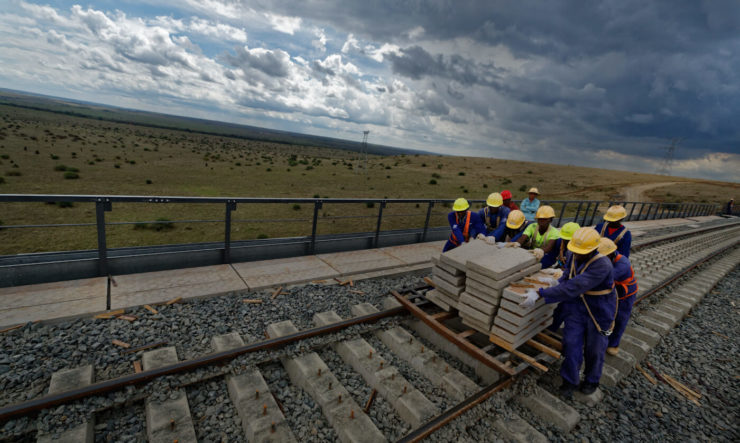
Transport corridors remain a major obstacle to the dynamic and integrated economic development of individual States and entire regional communities on the African continent, as the quality and quantity of roads and railways do not fully meet existing needs. Some of the factors contributing to the low level of transport infrastructure development in Africa compared to the global average include:
1) colonial past – the construction of transport corridors was carried out by Europeans in fact exclusively for the purpose of exporting natural resources and, thus, was not accompanied by the emergence of interconnected transport networks;
2) material constraints, including a severe shortage of money to finance infrastructure projects and technological difficulties;
3) environmental conditions, which include both geographical and security challenges. At the same time, there are a number of ambitious projects in Africa to create long international transport corridors. This article focuses on one such project.
The processes of decolonisation in Africa that rapidly unfolded in the 1960s and 1970s were accompanied by the spread of pan-African ideas and the emergence of numerous projects designed to overcome economic backwardness and provide conditions for integration, both regional and transcontinental. As a result, as early as 1970, with the support of the UN Economic Commission for Africa, the Trans-African Motorways initiative was formulated, a grand plan to create 9 road transport corridors totalling 56683 kilometres. Over the following decades, the African Union, the African Development Bank and numerous regional economic communities have been actively involved in financing, implementation and monitoring.
Thus, the proposed initiative envisaged, albeit without a fixed timeframe, the construction of 9 motorways, including both the use of existing road sections and the construction of new ones. Thus, the motorway network was to look as follows: 1) The Cairo-Dakar Motorway, over 8,600 kilometres long, runs mainly along the coast and connects existing roads rather than building new ones; 2) The Algiers-Lagos Motorway, over 4,500 kilometres long, was conceived in 1962 not only to link the Mediterranean coast and the Gulf of Guinea, but also to promote the economic development of the interior of Algeria and Niger; 3) The Tripoli-Windhoek trunk line is the longest corridor (9,600 km), much of which runs through the “disadvantaged” and sparsely populated territories of Libya, Chad, CAR, Congo and DRC, which reduces the economic importance of this transport artery; 4) Cairo-Gaborone Motorway – another “north-south” route, though playing a greater role than the previous one, the planned length of which was 8,861 kilometres with the possibility of extending it to 10,228 kilometres through the Gaborone-Cape Town section; 5) The Dakar-Ndjamena Highway is a relatively short route of 4,490 km between 4 capitals (Senegal, Mali, Niger and Chad); 6) The N’Djamena-Djibouti Highway is a 4,219 km road linking Chad and the interior of Sudan and Ethiopia with the port of Djibouti; 7) The Dakar-Lagos Highway is a link of just over 4,000 km between the capitals of 11 West African coastal states; 8) The 6259 km long Lagos-Mombasa Highway, designed to become a transport artery between the largest ports of West and East Africa, runs through the heart of the continent; 9) The Beira-Lobito Highway, the shortest (3523 km) of the Trans-African Highways, links the hinterland of the DRC, Zambia and Zimbabwe with the port infrastructure of Angola and Mozambique.
At the same time, the complex impact of the previously discussed problems of transport infrastructure development led to the fact that as of 2003 – more than 30 years after the initiative was approved – the degree of highways’ readiness left much to be desired. For example, in some cases (Trans-African Motorways 3, 6, 8), asphalt pavement covered no more than 60 per cent of the total length of the route, and some sections were virtually absent from the road map (“missing links”). In addition, even where the condition of the road surface allowed for the movement of cars and trucks, criminal, terrorist and insurgent groups controlling one or another inland area of the mainland were a significant obstacle to the free operation of the transport corridor.
At the same time, despite the lack of more up-to-date and comprehensive reports on the state of the Trans-African Motorways, it seems possible to note that even today such barriers as the actions of non-state actors and the weakness of the material and technical base remain the most fundamental problems on the way to realising the grandiose idea of the 1970s. For example, in the interior of the mainland – in the countries of the Sahel, CAR, DRC, and Congo – the critical weakness of state institutions makes progressive implementation of large-scale infrastructure projects almost impossible. It should be borne in mind that coordination of efforts to build and maintain the Trans-African Motorways is also difficult due to the overlapping areas of responsibility and interests of different regional economic communities. In contrast, less ambitious but more economically viable and cost-effective international transport corridor projects have recently been gaining popularity in all sub-regions of Africa, attracting both investment from TNCs and leading global players, including China.
Ivan KOPYTZEV – political scientist, research intern at the Centre for Middle Eastern and African Studies, Institute for International Studies, MGIMO, Russian Ministry of Foreign Affairs, especially for online magazine “New Eastern Outlook”